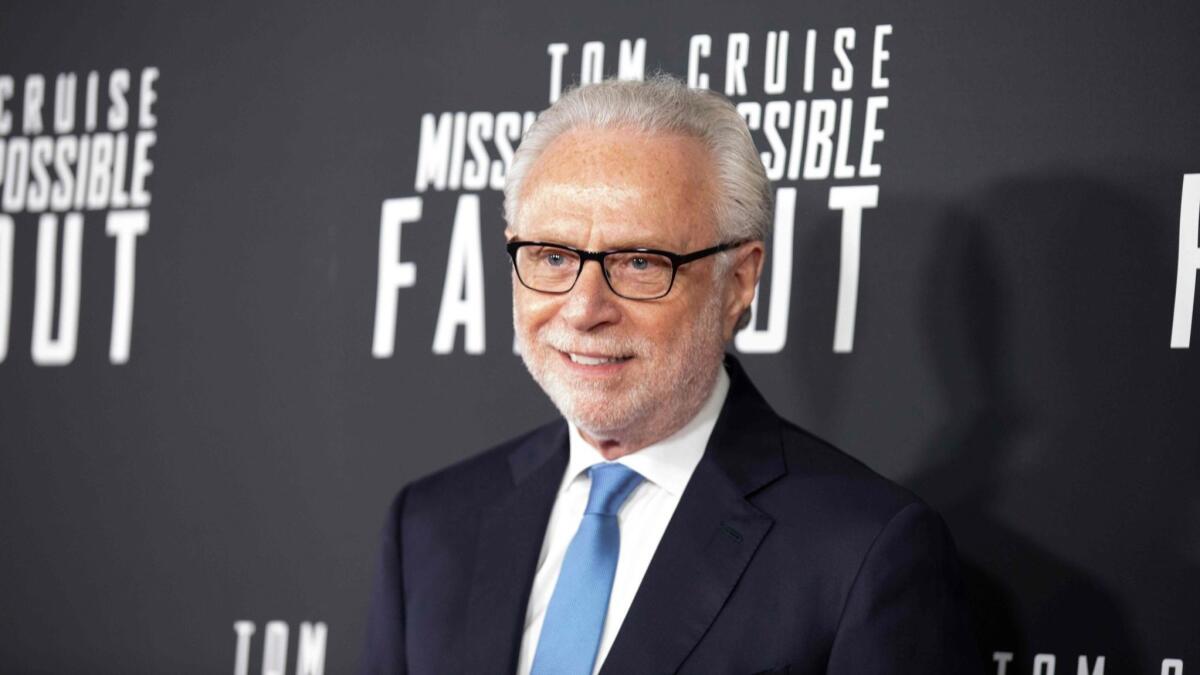Op-Ed: Journalists need to stop playing themselves in movies

- Share via
“Mission: Impossible — Fallout” has topped the box office two weekends in a row with some clever sequences, including one just before the opening credits. The real Wolf Blitzer plays a fake Wolf Blitzer. Fans of the franchise know that the Impossible Missions Force — or IMF — is adept at creating masks. In this bit, the team tricks an evil nuclear scientist into coughing up information by appearing to accede to his demand that CNN broadcast his manifesto.
There’s Blitzer on the small screen, reading the evil screed. But it’s all a fake. Once the intelligence is in hand, “Blitzer” pulls off his mask to reveal himself as one of the IMF agents. And then, the “Mission Impossible” music. So very cool.
Except that it’s totally uncool. Shtick like that really damages the news media’s credibility at a time when it can least afford it. Back in 1974, the great Walter Cronkite, succumbing to network pressure, made a quick cameo in an episode of “The Mary Tyler Moore Show.” As problematic as that was, it was a rare thing; the wall between news and entertainment was still intact. But no longer.
In 1997, the movie “Contact,” about extra-terrestrial research, drew heavy criticism because it was so loaded with CNN anchors and reporters. The head of the network called for an end to putting on-air staff in films.
Such scruples were short-lived. The number of famous journalists in movies and TV series has exploded. HBO’s “House of Cards” had Rachel Maddow, George Stephanopoulos and Lester Holt playing themselves. “Batman vs. Superman” featured Anderson Cooper and Soledad O’Brien, and there are plenty of other examples.
Enter the Fray: First takes on the news of the minute from L.A. Times Opinion »
Journalists aren’t immune from celebrity, and they like the paycheck that comes with it, but what really drives this is that huge media companies such as CNN’s parent WarnerMedia own a news network, movie distributors and production companies. From a business perspective, featuring network stars in fictional movies under the same corporate umbrella is cross-promotion, a win-win. Viewers and moviemakers probably like it because real news people add authenticity to the story.
Problem is, what burnishes fiction tarnishes fact, along with the journalists and outlets they represent. On social media, where many of us get our news, stories from reliable sources are right up against lies and chicanery. The public must constantly discriminate between truth and falsehoods. Fake-news sites plagued the 2016 election, and we have a president who continually assaults the veracity of journalism. His predominant target is CNN.
So why would CNN or WarnerMedia think it would be a good idea for Blitzer to play himself, and then turn out to be a Wolf in IMF clothing? Blitzer himself should have seen the problem with that.
CNN deserves credit for trying to serve the world with important, verified, accurate information. And journalists who are doing good work probably think movie cameos are the least of the problems facing news media. They may even buy into the idea that showing up in movies is “good for the brand.” But that kind of thinking ignores what the brand is. CNN stands for what’s true, and newscasters simply shouldn’t feed the blur between truth and fantasy.
Keep news staff in the field and in the newsroom — and off the set.
Keith Oppenheim is an associate professor of broadcast media production at Champlain College in Burlington, Vt., and a former correspondent for CNN.
Follow the Opinion section on Twitter @latimesopinionand Facebook
More to Read
A cure for the common opinion
Get thought-provoking perspectives with our weekly newsletter.
You may occasionally receive promotional content from the Los Angeles Times.






